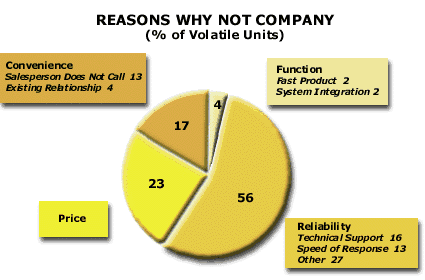Analysis 33: Reasons for Company Elimination
EXHIBITS:

| HOW TO INTERPRET THE ANALYSIS: The exhibit shows the reasons why the company was eliminated from competition for customers' volume and organizes those reasons under the categories of the Customer Buying Hierarchy: Function, Reliability, Convenience, and Price. Only 4% of the units that the company might have won did they lose due to Function. Most of the reasons the company was eliminated by potential customers have to do with Reliability. The company also suffered nearly a quarter of its losses of potential customer volume due to high price.
PURPOSE: This analysis rank orders the reasons that the company is eliminated when a customer chooses a new supplier. This analysis creates a picture of the reasons behind the company's "hidden", or opportunity, losses of volume. APPROACH: A very important aspect of the company's efforts to improve its product and service package is to make the changes necessary to avoid failures and eliminations. Analysis 32 rank orders the reasons for the average competitor's failing to be considered for potential new volume. This analysis is similar except that it is conducted on the company's specific experience. This analysis identities the reasons why customers, who did change suppliers, failed to choose to use the company. Product and service innovations to overcome reasons behind customers choosing not to use the company are important. These changes should address the key reasons why the company: (1) is not invited to bid for customer volume; (2) fails to be reviewed seriously if it submits a bid; or (3) is evaluated, but is not selected, as the customer's supplier. Product and service innovations should increase the amount of volatile customer volume the company sees and can convert into its own volume. This analysis results from estimates made by marketing and sales along with customer interviews. The analysis may have to be done on the basis of percentage of transactions, rather than on volume, because it may be difficult to estimate volume lost on an opportunity basis. To get around this problem, the company might estimate the size of the customer (i.e. VL, L, M, or S) and project volume based on volatile volume averages for that size of customer. Reasons "Why Not" Company: Industry Examples» For further description of how to use market data to develop performance innovations, see Analysis 35. Return to Diagnose Products and Services: Negative Hidden Volatility |
|
Recommended Reading |
| For a greater overall perspective on this subject, we recommend the following related items:
Analyses:
Symptoms and Implications: Symptoms developing in the market that would suggest the need for this analysis.
Perspectives: Conclusions we have reached as a result of our long-term study and observations.
|
